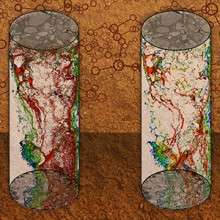Simulating subsurface flow and transport at multiple scales

Scientists at Pacific Northwest National Laboratory introduced a method that overcomes the computational challenge of simulating subsurface phenomena that occur at both the scale of tens to hundreds of microns-the size of solid soil grains and pore spaces-and at much larger scales. The researchers presented the first simulations of pore-scale flow and transport over a large, decimeter-scale volume.
By bridging the gap between small and large spatial scales, the simulation method could shed light on the effect pore-scale processes have on field-scale phenomena. This new method could pave the way for more accurate risk assessments of groundwater contamination and development of more effective remediation strategies.
The researchers performed multiscale simulations of pore-scale processes over a decimeter-scale volume of natural porous media with a wide range of grain sizes. They compared simulation results to findings from column experiments on the same sample. The researchers used X-ray computed tomography (XCT) to non-invasively image the sample and executed high-performance codes on a supercomputer to carry out the simulations. Because the XCT could not provide sufficient spatial resolution to identify pore spaces within fine-grained regions containing silt and clay, the team developed a multi-level segmentation approach in which the core was segmented into solid, pore, and porous solid regions. They evaluated two XCT image segmentation strategies: binary segmentation, which resolved pores and solids; and ternary segmentation, which resolved porous solids with pores smaller than the imaged resolution. They found simulations based on ternary segmentation, but not binary segmentation, provided results consistent with experimental observations, demonstrating their ability to successfully model pore-scale flow over a column-scale domain.
The researchers are continuing to make advances using this method, working to transfer knowledge of small-scale physical processes to larger-scale phenomena and dramatically improving the capability of numerical models to accurately predict behavior in complex systems.
More information: "Pore-Scale and Multiscale Numerical Simulation of Flow and Transport in a Laboratory-Scale Column." Water Resources Research 51(2):1023-1035. DOI: 10.1002/2014WR015959
Journal information: Water Resources Research
Provided by Pacific Northwest National Laboratory




















